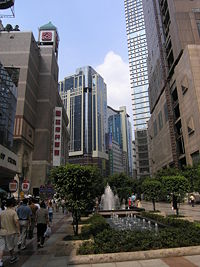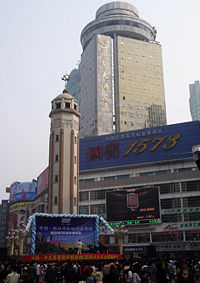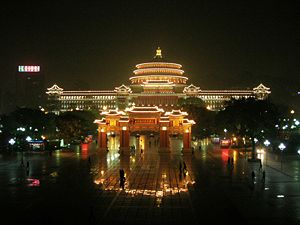Chongqing
| 重庆市 Chóngqìng Shì | |
| Abbreviations: 渝 (Pinyin: Yú) | |
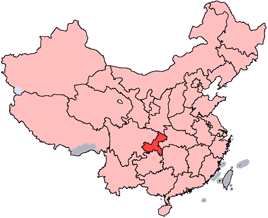
| |
| Origin of name | 重 chóng ("again") 庆 qìng ("celebrate") i.e. "double celebration" |
| Administration type | Municipality |
| Capital | 渝中区 Yuzhong Qu |
| CPC Ctte Secretary | 汪洋 Wang Yang |
| Governor | 王鸿举 WANG Hongju |
| Area | 82,300 km² (26th) |
| Population (2005) - Density |
6,363,000 (20th) 379/km² (10th) |
| GDP (2005) - per capita |
CNY 310 billion (24th) CNY 8,540 (20th) |
| HDI (2005) | 0.745 (medium) (18th) |
| Major nationalities | 91% Han 5% Tujia 2% Miao |
| Prefecture-level | |
| County-level | 40 divisions |
| Township-level† | 1259 divisions |
| ISO 3166-2 | CN-50 |
| Official website (Chinese) www.cq.gov.cn (English) english.cq.gov.cn/ Template:Addrow City tree || Ficus lacor
Template:Addrow City flower || 山茶花 Camellia | |
| Source for population and GDP data: 《中国统计年鉴—2005》 China Statistical Yearbook 2005 Source for nationalities data:ISBN 7503747382 《2000年人口普查中国民族人口资料》 Tabulation on nationalities of 2000 population census of China † As at December 31, 2004
ISBN 7105054255 | |
Chongqing (Simplified Chinese: 重庆; Traditional Chinese: 重慶; pinyin: Chóngqìng; Postal map spelling: Chungking; Wade-Giles: Ch'ung-ch'ing) is the largest and most populous of the People's Republic of China's four provincial-level municipalities, and the only one in the less densely populated western half of China. Formerly (until 14 March 1997) a provincial city within Sichuan Province, the municipality of Chongqing has a registered population of 31,442,300 (2005), with most of them living outside the urban area of Chongqing proper, over hundreds of square kilometres of farmland. The population of the urban area of Chongqing proper was 4.1 million in 2005.
The municipal abbreviation, 渝 (Yú), was approved by the State Council on 18 April 1997. Chongqing was also a municipality of the old Republic of China. Its abbreviated name is derived from the old name of a part of the Jialing River that runs through Chongqing and feeds the Yangtze River.
The urban area of Chongqing proper (重庆市区) includes the following districts:
- Yuzhong (渝中区, or "Central Chongqing District"), the central and most densely populated district, where government offices are located
- Nan'an (南岸区, or "Southern Bank District")
- Jiangbei (江北区, or "North of the River District")
- Shapingba (沙坪坝区)
- Jiulongpo (九龙坡区)
- Dadukou (大渡口区)
History
Chongqing is said to be the semi-mythical State of Ba that the Ba people supposedly established during the eleventh century B.C.E. By 316 B.C.E., however, it had been overrun by the State of Qin. The Qin emperor ordered a new city to be constructed, which was called Jiang (江州) and Chu Prefecture (楚州).
Chongqing was subsequently renamed in 581 C.E. (Sui Dynasty) and 1102, to Yu Prefecture (渝州) and then Gong Prefecture (). It received its current name in 1189, after Prince Zhao Dun of the Southern Song Dynasty described his crowning as king and then Emperor Guangzong as a "double/repeated happy celebration" (Simplified Chinese: 双重喜庆; Traditional Chinese: 雙重喜慶; pinyin: shuāngchóng xǐqìng). Hence, Yu Prefecture became Chongqing subprefecture to mark the occasion. [citation needed]
In 1362, (Yuan Dynasty), Ming Yuzhen, a peasant rebel leader, established the Daxia Kingdom at Chongqing for a short time.
In 1621, another short-lived kingdom of Daliang was established there.
In 1891, Chongqing became the first inland commerce port open to foreigners.
From 1929, Chongqing became a municipality of the Republic of China. During the Second Chinese-Japanese War (1937-1945), it was Chiang Kai-shek's provisional capital and was heavily bombed by the Japanese Air Force. Many factories and universities were moved from eastern China to Chongqing during the war, transforming it from inland port to a heavy-industrial city.
In 1954, the municipality was reduced to a provincial city within the Sichuan Province of the People's Republic of China.
On 14 March 1997, the Eighth National People's Congress decided to merge the city with the neighbouring Fuling, Wanxian, and Qianjiang prefecture-level districts that it had governed on behalf of the province since September 1996. The resulting single division was the Chongqing Municipality, containing 30,020,000 people in forty-three former counties (without intermediate political levels). The municipality became the spearhead of China's effort to develop its western regions and coordinate the resettlement of refugees from the Three Gorges Dam project. Its first official ceremony took place on 18 June 1997. The city went through massive flooding in the summer of 2007.
Administrative divisions
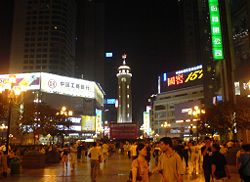
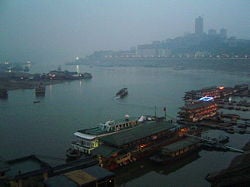
Chongqing Municipality is divided into forty county-level subdivisions (three abolished in 1997), consisting of nineteen districts, seventeen counties, and four autonomous counties.
|
|
| Pinyin name | Hanzi | Previous associationa |
|---|---|---|
| Pengshui Miao and Tujia | 彭水苗族土家族自治县 | Qianjiang |
| Shizhu Tujia | 石柱土家族自治县 | |
| Xiushan Tujia and Miao | 秀山土家族苗族自治县 | |
| Youyang Tujia and Miao | 酉阳土家族苗族自治县 |
a Indicates with which district the division was associated below prior to the merging of Chongqing, Fuling, Wanxian (now Wanzhou) and Qianjiang in 1997.
Geography
- Geographic coordinates
- 105°17'-110°11' East, 28°10'-32°13' North
- Annual average temperature
- 18°C (64°F)
- Temperature range
- 0 C - 43 C (32 F - 109 F)
- Total annual hours of sunshine
- 1000 to 1200
- Annual precipitation
- 1000 to 1400 mm (39 in - 47 in)
- Neighboring provinces
- Hubei (east), Hunan (east), Guizhou (south), Sichuan (west), Shaanxi (north)
Located on the edge of the Yungui Plateau, Chongqing is intersected by the Jialing River and the upper reaches of the Yangtze. It contains Daba Shan in the north, Wu Shan in the east, Wuling Shan in the southeast, and Dalou Mountain to the south.
The city is very hilly and is the only major metropolitan area in China without significant numbers of bicycles.
Economy
Historically, Chongqing has been a major trading inland port, transporting goods from the southwestern provinces to eastern China. During the Sino-Japanese War (1937-1945), Chongqing was transformed into a heavy industrial city, especially the military industry which continued to thrive for decades after 1949. Since the 1980s, many of these military industry enterprises have undergone reforms and turned from producing military goods to mostly civilian products for survival and growth. [2]
Chongqing is rich in natural resources, with more than forty kinds of minerals. Its coal reserves are estimated to be 4.8 billion tonnes. The Chuandong Natural Gas Field in Chongqing is China's largest inland production base of natural gas, with deposits of 270 billion m³, accounting for more than one-fifth of China's total. Chongqing contains China’s largest reserve of strontium, and China has the second largest reserve of the mineral in the world.
Important industries in Chongqing:[3]
- Mining
- Iron, steel, aluminum
- South West Aluminium
- Military
- Auto, motorcycle
- Lifan
- Chemical
- Textiles
- Machinery
- Electronics
- Building materials
- Food processing
- Retail
- Tourism [4]
Chongqing is home to Asia's largest aluminum plant, South West Aluminium, which rolled out 213,000 tonnes of finished products in 2004 for companies engaged in building materials, printing, electrical appliances, aerospace, packaging, and vehicle production [5]. Manganese mining is the most important industry in the Xiushan area, but has been criticised for wasting resources, ruining the local environment and causing industrial accidents. A survey in 2005 by China’s State Environmental Protection Administration (SEPA) found 13 firms in the manganese triangle had breached targets on the release of hexavalent chromium and ammonia-nitrogen – in the worst case, by a factor of 180. The clean-up ordered by SEPA resulted in firms closing and the expenditure of 280 million yuan.
Chongqing's agricultural sector still employs a significant portion of the population. Other than rice, fruits especially oranges are important sources of income for the farmers. In the past twenty-five years, surplus labor resulted a huge number of farmers to migrate to the relatively more developed industrial centers of southern and eastern China for employment opportunities, thus making Chongqing one of the biggest labor export areas in China.
The central government has recently embarked on an economic policy that is aimed to develop western China: the China Western Development strategy. As part of this new plan, the central government has heavily invested in Chongqing's infrastructure and has made a plan for Chongqing to become the "Gateway to the West." Located at the head of the reservoir behind the Three Gorges Dam, Chongqing is planned to be the beachhead for the development of the western part of the country. With the completion of the Three Gorges project, its reservoir will bring ocean going ships to the quays of Chongqing. The hope is that this gritty fogbound megalopolis may become a Chinese Chicago, opening up the interior, shifting the country's centre of gravity west, and kick-starting the economy – as did Chicago in the United States of the nineteenth century. Massive public works are currently under way in the city, including overhead and surface commuter rail lines connecting the many districts of the city. Foreign investment in the city is growing at a fast pace. Chongqing is enlarging its commercial sector. New development zones such as the Chongqing New North Zone (CNNZ) located north of the downtown district have been established to form Chongqing's modern twenty-first century industrial base. [6]
In 2005, the nominal GDP of Chongqing municipality was 310 billion yuan (US$38.75 billion), a rise of 11.5% year-on-year. Its per capita GDP was 11,068 yuan (US$1,383). The primary, secondary, and tertiary industries of Chongqing were worth 46.342 billion yuan, 125.832 billion yuan, and 134.736 billion yuan, respectively. [7]
Media
Chongqing is served by the Chongqing People's Broadcast Station, a television station.
Transportation
Chongqing is the biggest inland river port in western China. Historically, most of its transportation, especially to eastern China, is via the Yangtze River.
Chongqing is also now linked to other parts of the country through several railways and highways, including:
- Chongqing-Chengdu (Sichuan province) railway
- Chongqing-Guiyang (Guizhou province) railway
- Chongqing-Xiangfan (Hubei province) railway
- Chongqing-Huaihua (Hunan province) railway
- Chongqing-Suining (Sichuan province) express railway
- Wanzhou-Yichang (Hubei province) railway (under construction)
- Chongqing-Lanzhou (Gansu province) railway (under construction)
- Chongqing-Chengdu highway
- Chongqing-Wanxian highway
- Chongqing-Guiyang highway
Also, Chongqing Jiangbei International Airport, located north of Chongqing provides links to most parts of China and to other countries and regions such as Hong Kong, Japan, Korea, and Thailand.
Meanwhile, the transportation system in the metropolitan area is also being developed to modern standards. Due to its hilly geography and Yangtze and Jialing rivers which run through it, ground transportation in the city requires an unusual number of bridges and tunnels, which increases cost dramatically. As a result, public transportation in the city is vulnerable to lapses in safety, also owing to the fact that the public transportation system is semi-privatized with little regulation. However, the highway network around the city and to nearby satellite towns is almost completed. One unique form of transportation in the city are the cable cars which are suspended over the rivers. Recently, the Chongqing Metro was completed and entered service in January 2005.
Climate
The climate is semi-tropical, with the two-season monsoonal variations typical of South Asia. It has hot summers, and the temperature can be as high as 43°C (109°F). Along with Wuhan and Nanjing, it is known as one of the "three furnaces" of China. In the winter, it is wet and warm. While it seldom snows, most days are foggy.
The typically severe fogs were protective during World War II as the city was periodically bombarded by Japanese aircraft; their aircrews were unable to target their bombs accurately. The prevalent black tile roofs of buildings would also tend to blend into the ground colors and so became an effective form of camouflage.
As is true of most of China, the city often experiences severe air pollution, largely as a result of the burning of coal without pollution controls. Coal is burned both for industrial processes and for the production of electric power. Also, due to the surrounding mountains, a lack of wind makes the air pollution in the city even worse.
Tourism
Chongqing and surrounding areas are full of tourism resources. The most famous is the Three Gorges, a scenic area along Yangtze river. The 200-km long area is the most visited canyon in China. Besides its gorgeous natural scene, it is also a culturally rich area. Other tourism sites include Dazu Rock Carvings, mainly Buddhist themes, it was carved from the Tang Dynasty, now belongs to UNESCO World Heritage.
City sightseeing is also part of Chongqing tourism, with historic World War II sites located in the metropolitan area. Outside the city, Fishing Town marks where the Mongol prince Mongke Khan was defeated in 1243, stopping the Mongol expansion toward Europe and Africa.
According to a Reuters press release, in 2005 Chinese tourism authorities started a project to build a "women’s town" in the Shuangqiao district of Chongqing municipality as a tourist attraction. The motto of Longshuihu village is "women never make mistakes, and men can never refuse women's requests." According to one official (surname Li), "Traditional women dominate and men have to be obedient in the areas of Sichuan province and Chongqing, and now we are using it as an idea to attract tourists and boost tourism." The tourism bureau is investing between 200 million yuan ($26 million) and 300 million yuan in infrastructure, roads and buildings for the 2.3-square-km village and is seeking outside investors as well. The project is expected to be completed in 2008-2010. [1]
Astronomical phenomena
The previous total solar eclipse as seen from downtown Chongqing was the solar eclipse of 26 June 1824. The next will be the solar eclipse of 22 July 2009.
Landmarks
- The city is home to one of the largest public assembly buildings in China, the Great Hall of the People, built in modern times but emulating traditional architectural styles. This is adjacent to the densely populated and hilly central district, with narrow streets and pedestrian only walkways.
- There is a museum at the World War II headquarters of General "Vinegar Joe" Stilwell.
- A giant ferris wheel offers spectacular views of the metropolitan area, although it is currently out of action.
- A modern and well stocked zoo exhibits many national and regional animals, including the Giant Panda and the extremely rare South China Tiger.
- The People's Liberation Monument is located in the center of ChongQing city, and it attracts a lot of tourists, and also it is surrounded by a few shopping centers.
- Red Rock Village Museum is a place to attract a lot of people, it is the home of Communist Party Leaders Mao Zedong and Zhou Enlai stayed there for negotiation with Kuomintang on coalition between two parties.
- In July 2007, the city built a bathroom with 1,000 toilets spread out over 32,290 square feet. Some urinals are uniquely shaped, including ones inside open crocodile mouths and several that are topped by the bust of a woman resembling the Virgin Mary. Officials submitted an application to Guinness World Records to have the free four-story public bathroom listed as the world's largest. [2]
Sister cities
 Washington, D.C., USA
Washington, D.C., USA Düsseldorf, Germany
Düsseldorf, Germany Seattle, USA
Seattle, USA Hiroshima, Japan
Hiroshima, Japan Mito, Ibaraki, Japan
Mito, Ibaraki, Japan Toronto, Canada
Toronto, Canada Brisbane, Australia
Brisbane, Australia Toulouse, France
Toulouse, France Leicester, England
Leicester, England Detroit, Michigan, USA
Detroit, Michigan, USA- Template:Country data IRI Shiraz, Iran
City tree
The city's tree is the evergreen magnolia (magnolia delavayi) abundant in street plantings, with the tulip-like shape of its mature unopened blooms repeated in street lights.
Colleges and universities
| Chongqing University | 重庆大学 | founded in 1929 |
| Southwest University | 西南大学 | founded in 1906 |
| Chongqing Institute of Technology | 重庆工学院 | |
| Chongqing Jiaotong University | 重庆交通学院 | |
| Chongqing Normal University | 重庆师范大学 | |
| Chongqing Technology and Business University | 重庆工商大学 | |
| Chongqing Three Gorges University | 重庆三峡学院 | |
| Chongqing University of Posts and Telecommunications | 重庆邮电学院 | |
| Yangtze Nomal University | 长江师范学院 | founded in 1931 |
| Sichuan Fine Arts Institute | 四川美术学院 | |
| Sichuan International Studies University | 四川外语学院 | |
| Southwest University of Political Science and Law | 西南政法大学 | |
| Third Military Medical University | 第三军医大学 | |
| Western Chongqing University | 渝西学院 | |
| Chongqing University of Medical Sciences | 重庆医科大学 | |
| Chongqing University of Science and Technology | 重庆科技学院 |
Institutions without full-time bachelor programs are not listed.
See also
- List of cities in the People's Republic of China by population
Sports
Professional sports teams in Chongqing include:
- Chinese Football Association Super League
- Chongqing Lifan
- Chinese Basketball Association
- None
Notes
ReferencesISBN links support NWE through referral fees
- Chongqing China. 2005. Chongqing, People's Republic of China: The Foreign Affairs Office, Chongqing Municipal Govt.
- Kucharzik, Jan, and Ursula Panhans-Bühler. 2001. Chongqing la jiao. Frankfurt am Main: Stroemfeld. ISBN 3878777760 9783878777762
- Li, Si-ming, Yim-ha Leung, and Zheng Yi. 2006. Fragmentation or integration? a study of Chongqing, the largest city of China. [Kowloon Tong, Hong Kong]: Centre for China Urban and Regional Studies, Hong Kong Baptist University. ISBN 9789628804634 9628804634
- Nasby, Judith. 2006. Contemporary painting from Chongqing. Guelph, Ont: Macdonald Stewart Art Centre. ISBN 0920810810 9780920810811
- Pan, Yu-hong. 2007. Application of industrialized housing system in major cities in China a case study of Chongqing. Hong Kong: Dept. of Building and Real Estate, The Hong Kong Polytechnic University.
- RSKT 2006, and Guoyin Wang. 2006. Rough sets and knowledge technology first international conference, RSKT 2006, Chongqing, China, July 24-26, 2006 : proceedings. Berlin: Springer. ISBN 3540362975 9783540362975
- Shaw, Raynor, Paul Mooney, and Bill Hurst. 2006. Three gorges of the Yangtze River Chongqing to Wuhan. Hong Kong: Odyssey. ISBN 9622177743 9789622177741
- Yang, Shaoquan. 2002. New Chongqing City. [Chongqing, China]: Chongqing Pub. House. ISBN 7536656343 9787536656345
- Yang, Shaoquan. 2005. Chongqing charm. Chongqing, China?: s.n.]. ISBN 7536674082 9787536674080
External links
- Big, Gritty Chongqing, City of 12 Million, Is China’s Model for Future New York Times
- Comprehensive Website and Forum about Life in Chongqing
- Information about Chongqing for expats /
- City centre map
- District map / Version 2 Simplified Chinese
- The Guardian, 15 March 2006, "Invisible city"
- Large map of Chongqing region
- Google map satellite image
- Official site (English) Official site (Simplified Chinese)
- Chongqing Life Guide
- Article on Gongtan, a remote 1,700 year-old Chongqing village to be bulldozed for powerplant
| |||||||||||||||||
| Province-level divisions administered by the People's Republic of China (PRC) | |
|---|---|
| Provinces | Anhui · Fujian · Gansu · Guangdong · Guizhou · Hainan · Hebei · Heilongjiang · Henan · Hubei · Hunan · Jiangsu · Jiangxi · Jilin · Liaoning · Qinghai · Shaanxi · Shandong · Shanxi · Sichuan · Taiwan · Yunnan · Zhejiang |
| Autonomous regions | Guangxi · Inner Mongolia · Ningxia · Tibet (Xizang) · Xinjiang |
| Municipalities | Beijing · Chongqing · Shanghai · Tianjin |
| Special administrative regions | Hong Kong · Macau |
sh:Chongqing
Credits
New World Encyclopedia writers and editors rewrote and completed the Wikipedia article in accordance with New World Encyclopedia standards. This article abides by terms of the Creative Commons CC-by-sa 3.0 License (CC-by-sa), which may be used and disseminated with proper attribution. Credit is due under the terms of this license that can reference both the New World Encyclopedia contributors and the selfless volunteer contributors of the Wikimedia Foundation. To cite this article click here for a list of acceptable citing formats.The history of earlier contributions by wikipedians is accessible to researchers here:
The history of this article since it was imported to New World Encyclopedia:
Note: Some restrictions may apply to use of individual images which are separately licensed.

